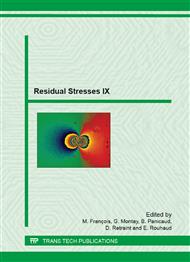p.924
p.930
p.936
p.944
p.951
p.958
p.964
p.969
p.975
Residual Stress Evaluation of Short-Fiber Reinforced Plastics by X-Ray Diffraction
Abstract:
The X-ray diffraction method is used to evaluate the residual stress in injection-molded plates of short-fiber reinforced plastics (SFRP) made of crystalline thermoplastics, polyphenylene sulphide (PPS), reinforced by carbon fibers with 30 mass%. The stress in the matrix in the skin layer was determined using Cr-Kα radiation with the sin2 ψ method. The X-ray evaluation of stress in carbon fibers was not possible because of high texture. A new method was proposed to evaluate the macrostress in SFRP from the measurement of the matrix stress. According to micromechanics analysis of SFRP, the matrix stresses in the fiber direction and perpendicular to the fiber direction, and shear stress can be expressed as linear functions of the applied (macro-) stresses in the fiber direction and perpendicular to the fiber direction, and shear stress. The proportional constants are named stress-partitioning coefficients. Using skin-layer strips cut parallel, perpendicular and 45° to the molding direction, the stress in the matrix was evaluated under the uniaxial applied stress and the stress-partitioning coefficients of the above equations were determined. Once the relations between the macrostress and matrix stress are established, the macrostress in SFRP can be evaluated from the measurements of the matrix stresses using X-rays.
Info:
Periodical:
Pages:
951-957
Citation:
Online since:
August 2014
Authors:
Permissions:
Share:
Citation:


